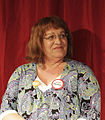Portal:Transgender
Welcome to the Transgender portal Being transgender is distinct from sexual orientation, and transgender people may identify as heterosexual (straight), homosexual (gay or lesbian), bisexual, asexual, or otherwise, or may decline to label their sexual orientation. The opposite of transgender is cisgender, which describes persons whose gender identity matches their assigned sex. Accurate statistics on the number of transgender people vary widely, in part due to different definitions of what constitutes being transgender. Some countries, such as Canada, collect census data on transgender people. Generally, fewer than 1% of the worldwide population are transgender, with figures ranging from <0.1% to 0.6%. Many transgender people experience gender dysphoria, and some seek medical treatments such as hormone replacement therapy, gender-affirming surgery, or psychotherapy. Not all transgender people desire these treatments, and some cannot undergo them for financial or medical reasons. The legal status of transgender people varies by jurisdiction. Many transgender people experience transphobia, or violence or discrimination towards transgender people, in the workplace, in accessing public accommodations, and in healthcare. In many places, they are not legally protected from discrimination. Several cultural events are held to celebrate the awareness of transgender people, including Transgender Day of Remembrance and International Transgender Day of Visibility, and the transgender flag is a common transgender pride symbol. (Full article...) Selected articleBoys Don't Cry is a 1999 American biographical film directed by Kimberly Peirce, and co-written by Peirce and Andy Bienen. The film is a dramatization of the real-life story of Brandon Teena (played by Hilary Swank), an American trans man who attempts to find himself and love in Nebraska but falls victim to a brutal hate crime perpetrated by two male acquaintances. The film co-stars Chloë Sevigny as Brandon's girlfriend, Lana Tisdel. After reading about the case while in college, Peirce conducted extensive research for a screenplay, which she worked on for almost five years. The film focuses on the relationship between Brandon and Lana. The script took dialogue directly from archive footage in the 1998 documentary The Brandon Teena Story. Many actors sought the lead role during a three-year casting process before Swank was cast. Swank was chosen because her personality seemed similar to Brandon's. Most of the film's characters were based on real-life people; others were composites. Filming occurred during October and November 1998 in the Dallas, Texas area. The producers initially wanted to film in Falls City, Nebraska, where the real-life events had taken place; however, budget constraints meant that principal photography had to occur in Texas. The film's cinematography uses dim and artificial lighting throughout and was influenced by a variety of styles, including neorealism and the films of Martin Scorsese, while the soundtrack consisted primarily of country, blues, and rock music. The film's themes include the nature of romantic and platonic relationships, the causes of violence against LGBT people, especially transgender people, and the relationship among social class, race, and gender. (Full article...) Selected biography Christine Jorgensen 30 May 1926 in The Bronx, New York City, USA; died 3 May 1989) was famous in the USA for having been the first widely-known individual to have sex reassignment surgery—in this case, male to female. The second child of George William Jorgensen Sr., a carpenter and contractor, and his wife, the former Florence Davis Hansen, Jorgensen grew up in the Bronx and later described herself as having been a "frail, tow-headed, introverted little boy [sic] who ran from fistfights and rough-and-tumble games". Did you know (auto-generated) -
This month's birthdays
More did you know...
Random quoteThe misconception of equating ease of life with “passing” must be dismantled in our culture. The work begins by each of us recognizing that cis people are not more valuable or legitimate and that trans people who blend as cis are not more valuable or legitimate. We must recognize, discuss, and dismantle this hierarchy that polices bodies and values certain ones over others. We must recognize that we all have different experiences of oppression and privilege, and I recognize that my ability to blend as cis is one conditional privilege that does not negate the fact that I experience the world as a trans woman (with my own fears, insecurities, and body-image issues) no matter how attractive people may think I am. Related portalsSelected picturesTopics
CategoriesWikiProjects WikiProjects are non-hierarchical peer-run groups which serve as a resource for the communication on, and collaboration of, content within a specific topic area. Related WikiProjects: Things you can do
Associated WikimediaThe following Wikimedia Foundation sister projects provide more on this subject:
|





























